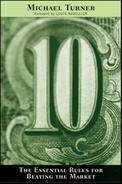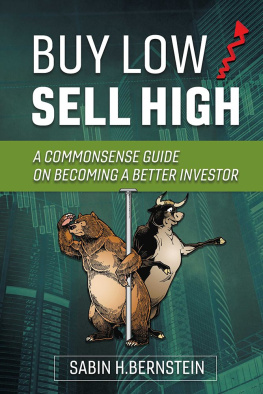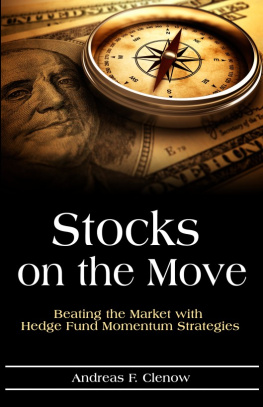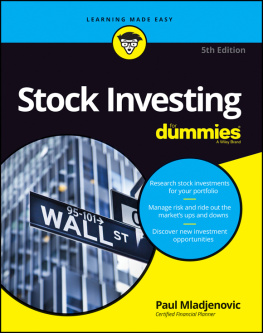Copyright
Copyright 2009 by Michael K. Turner. All rights reserved.
Published by John Wiley & Sons, Inc., Hoboken, New Jersey.
Published simultaneously in Canada.
No part of this publication may be reproduced, stored in a retrieval system, or transmitted in any form or by any means, electronic, mechanical, photocopying, recording, scanning, or otherwise, except as permitted under Section 107 or 108 of the 1976 United States Copyright Act, without either the prior written permission of the Publisher, or authorization through payment of the appropriate per-copy fee to the Copyright Clearance Center, Inc., 222 Rosewood Drive, Danvers, MA 01923, (978) 750-8400, fax (978) 750-4470, or on the web at www.copyright.com. Requests to the Publisher for permission should be addressed to the Permissions Department, John Wiley & Sons, Inc., 111 River Street, Hoboken, NJ 07030, (201) 748-6011, fax (201) 748-6008, or online at www.wiley.com/go/permissions.
Limit of Liability/Disclaimer of Warranty: While the publisher and author have used their best efforts in preparing this book, they make no representations or warranties with respect to the accuracy or completeness of the contents of this book and specifically disclaim any implied warranties of merchantability or fitness for a particular purpose. No warranty may be created or extended by sales representatives or written sales materials. The advice and strategies contained herein may not be suitable for your situation. You should consult with a professional where appropriate. Neither the publisher nor author shall be liable for any loss of profit or any other commercial damages, including but not limited to special, incidental, consequential, or other damages.
For general information on our other products and services or for technical support, please contact our Customer Care Department within the United States at (800) 762-2974, outside the United States at (317) 572-3993 or fax (317) 572-4002.
Wiley also publishes its books in a variety of electronic formats. Some content that appears in print may not be available in electronic books. For more information about Wiley products, visit our web site at www.wiley.com.
Library of Congress Cataloging-in-Publication Data: Turner, Michael K., 1947
10 : the essential rules for beating the market / Michael K. Turner.
p. cm.
Includes index.
ISBN 978-0-470-29261-7 (cloth)
1. Investments. 2. Speculation. I. Title. II. Title: Ten, the essential rules for beating the market.
HG4521.T87 2009
332.6dc22
2008036132
Printed in the United States of America
10 9 8 7 6 5 4 3 2 1
Foreword
Many of you may know me from your own investing track record. Perhaps we have met at some of the trading show venues. The first time I met Mike Turner I was impressed by his skills to make the market work for him, rather than the other way around. We both enjoy the excitement of investing in the stock market. I was delighted to hear that Mike was writing a book about his 10 essential rules for beating the market. Being an engineer, Mike's approach to investing is very structured. I was afraid his writing might come across as overly analytical. But, after reading his book, I was amazed at how Mike is able to convey his very successful investment techniques and methodologies into a fun to read and yet powerful book that will make you a much better stock market investor.
I have spent my life building portfolios and teaching thousands of investors how to improve their success rate in the stock market. There have been thousands of books written on the subject. But Mike's 10 rules are truly a "best practices" how-to book for every investor. You will not want to put this book down once you start reading it.
The market, of late, has been extremely tough on everyone. But Mike's own portfolio, which explicitly follows his rules, not only came through this tough market unscathed, but generated returns that most investors only dream of. He accomplished this amazing feat due to following the rules he conceived to help him navigate these rough waters. We are fortunate that he has chosen to share them with all of us who wish to capture the best the market has to offer, regardless of what it throws at us from time to time! Being in the market doesn't have to be intimidating, and it doesn't have to produce sleepless nights. We simply need a plan to follow. If you put Mike's 10 rules to work, you will have an unbeatable investment plan.
This book is a must read for both serious and novice investors. His no-nonsense style, mixed with commonsense rules, can immensely help investors make better and wiser decisions. If he had asked me what to title the book, I would have said, "The 10 Commandments for Investing," for it represents rules by which all investors should live their investing lives.
Of Mike's 10 rules, it would be hard for me to pick a favorite one, since they all represent good commonsense rules for investors to follow. If I were forced to pick a favorite, however, it would be : "Think Like a Fundamentalist." As I've learned over recent years, fundamental investing has increasingly gone out of fashion with Wall Street, which seems more obsessed with "structured management" (i.e., building better benchmarks), and "arbitrage strategies" (i.e., quantitative long/short models). These two concepts often represent up to half the trading volume on many days and have given rise to increasing stock market volatility, as we have witnessed, all of which makes traders very nervous. If individual investors would make their trading decision based on fundamentals, then the stocks they select typically would be much less volatile, and would move in a more orderly and predictable manner. This would be extremely beneficial to holding onto gains and preventing large losses.
But what I like most about Mike's approach to building a disciplined investment strategy is that he combines the very best of a fundamental approach but relies heavily on technical trends to pick the best time to buy and sell.
I really like his approach to selling. I agree with him that most investors have no idea when to sell. His straightforward approach of turning that unknown into a simple but profound formula is pure genius. There should be more engineers running investment firms. We would have far fewer financial catastrophes if there were more strategic and disciplined investors who would use Mike's 10 rules for investing!
Each of us wishes to make the best of the marketin good times and especially in bad. In this regard I feel that Mike is a visionary and will provide you with a set of rules to guide you on a steady course so you do not get distracted or derailed completely by the stock market's gyrations. I know you will enjoy Mike's book and come to use it as a reference tool every time you are evaluating new stocks to buy or sell.
I hope you will put Mike's rules to work for yourself and see that you, too, can make consistent profits in the stock market.
Thank you, Mike, for generously sharing these rules with all of us in the trading world.
Louis Navellier
Preface
Odds are you do not know me, and, as such, it seems appropriate that I tell you a little about who I am and how it is that I have written this book. After all, I am going to ask you to make the 10 rules in this book an integral part of your life when it comes to investing in and profiting by investing in the stock market.
You should know that I do not come from the world of finance. In fact, when I started out in my professional career, I never dreamed that I would be where I am today. I'll get to that part in a bit.
You see, I started out in life as a civil engineer. My goal was to build massive structures that would be of great benefit to mankind. But a fledgling engineer just graduating from college is never put in charge of building great structures. In fact, most new civil engineering grads are lucky if they get to design handrails for second-story apartmentsbut, I digress.









